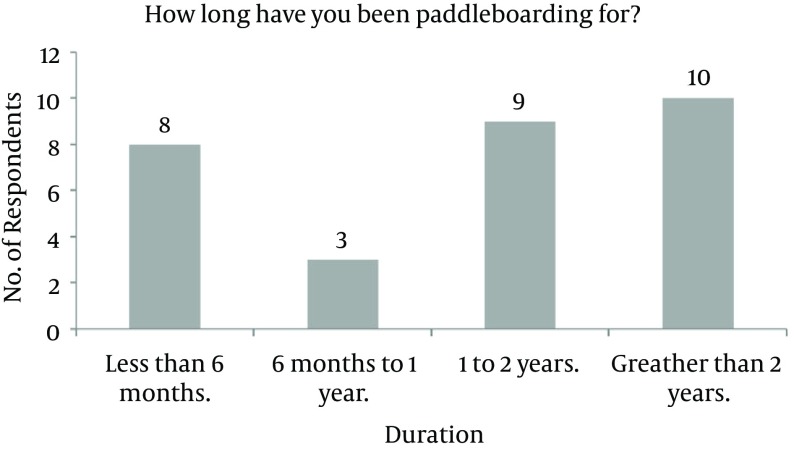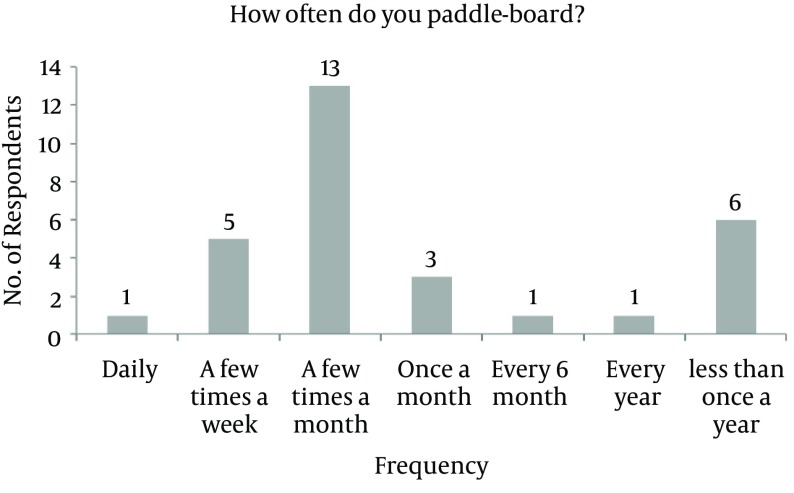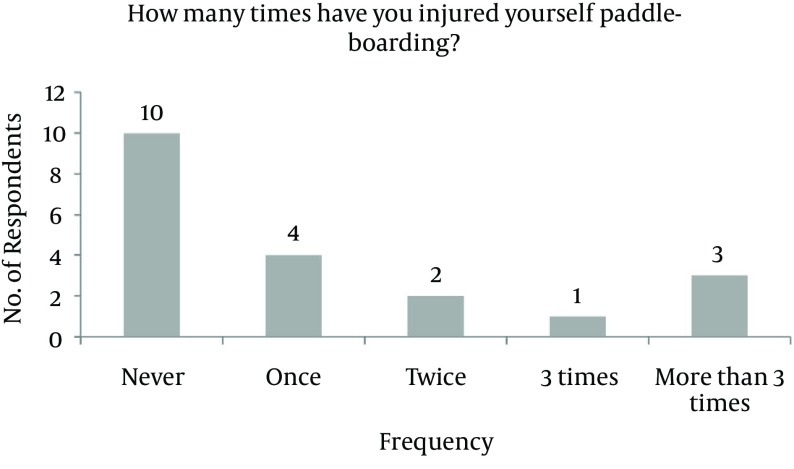Abstract
Background
Stand-up paddle-boarding is an increasingly popular water sport; however no published data to our knowledge exists on the nature and type of injuries sustained in this sport.
Objectives
This study aims to describe the frequency, pattern, and mechanism of paddle-boarding injuries.
Materials and Methods
Descriptive data of paddle-boarding injuries were collected using an interactive website-based, multiple-choice survey. Data were collected from May 2012 over a 6-month period.
Results
Completed surveys were obtained from 142 individuals, 20 paddle-boarders reporting 18 injuries and 122 surfers reporting 4 paddleboard-related injuries. Fifty percent of responding paddle-boarders reported an injury. For all injuries sustained paddle-boarding, sprains accounted for 50% (n = 9), lacerations for 22% (n = 4), contusions 17% (n = 3) and fractures 5% (n = 1). Seventy-eight percent of injuries were to the lower extremity, and 17% to the head and neck. Seventeen percent (n = 3) sustained recurrent injuries, 2 sustained 2 twisting knee injuries resulting in sprains, one sustained > 3 ankle injuries, resulting in sprains. Seventeen percent of injuries resulted from contact with one’s own paddle-board, 17% from another paddle-board, and 5% from the sea floor.
Conclusions
All paddle-boarding injuries were sustained by individuals who surf waves on a paddle-board, rather than paddle on calm water. Despite concerns, paddle-board related injuries only accounted for 1% of 326 injuries suffered by surfers. We suggest equipment and practice modifications that may decrease the risk for injury and challenge the anecdotal theory that paddle-boarding injuries are sustained due to inexperience.
Keywords: Injury, Paddle, Surfing, Trauma
1. Background
Stand-up paddle-boarding is the new, trendy, water sport that is growing in popularity. The reported health benefits of this new sport are well documented, particularly in building up core strength (1, 2). There is little data however, as to the type of injuries sustained whilst participating in this energetic pass-time. The anecdotal theory that paddle-boarding causes worse injuries than surfing due to a mix of inexperience as well as the larger size of the paddleboard in comparison to a surfboard is not well-founded. This article aims to identify the common injuries sustained whilst paddle-boarding and to determine if its benefits outweigh the risks.
Stand-up paddle-boarding could be described as a merger of surfing and canoeing, where a single long paddle is used to propel the rider standing on a longer, larger and more buoyant type of surf board. Native Hawaiians are credited for this relatively new water-sport, which is now globally popular. The health advantages boasted by the sport include core muscle training and cardio-vascular benefits (1, 2). There is anecdotal evidence of injuries sustained by paddle-boarders, or of injuries sustained by other water-users from paddle-boarders, with most blaming the increased size and manoeuvring difficulty of the boards, the relative inexperience of riders and the difficulty transitioning from riding calm, flat water (rivers/lakes) to catching waves.
2. Objectives
To our knowledge, there is no published data on the nature and frequency of injuries that this sport can cause and we sought to assess this.
3. Materials and Methods
We conducted an interactive web-based survey, to identify the most common type of injuries, and how they were sustained from May to November 2012. Surveys were sent to surfing clubs in the UK. Participants electronically acknowledged that their responses would remain anonymous.
4. Results
Thirty-one stand-up paddle-boarders and 144 surfers responded to the web-based survey.
4.1. Experience
Thirty stand-up paddle-boarders responded regarding levels of experience as illustrated in Figure 1; 27 % (n = 8) had been boarding for less than 6 months, the majority (33%) having practiced the sport for greater than 2 years.
Figure 1. Previous Paddle-Boarding Experience.
Seventy three percent (n = 22) of paddle-boarders participate in the activity at least once a month (Figure 2).
Figure 2. Frequency of Paddle-Boarding Activity.
Only 13% percent (n = 4) paddle-boarded purely on flat water. The majority, 87% (n = 26) paddle-boarded on open sea yet only 31% (n = 8) of these, 27% of the total paddle-boarders, surfed on waves with a stand up paddleboard. Forty percent (n = 3) of those who surfed waves on a stand up paddleboard considered themselves as beginners or amateurs and 60% (n = 5) as intermediate or advanced.
4.2. Injuries Sustained While Standing-up and Paddle-Boarding
Twenty people responded regarding injuries sustained whilst paddle-boarding. As illustrated in Figure 3, Ten (50%) had never sustained any kind of injury from the sport. The remaining 10 people sustained 18 injuries; with sprains accounting for 50% (n = 9), lacerations for 22% (n = 4), contusions 17% (n = 3) and fractures 5% (n = 1). One in 5 (n = 4) had been injured more than 3 times, all of whom surfed waves whilst stand-up paddle-boarding.
Figure 3. Number of Injuries Sustained Whilst Paddle-Boarding.
Of the 10 people sustaining injuries paddle-boarding, 3 sustained isolated injuries to the head/face, 1 sustained an isolated injury to the elbow/shoulder, 5 people sustained a total of 7 injuries to the knee, and 4 people injured their feet/ ankles and one was injured more than 3 times. The results are summarised in Table 1.
Table 1. The Location and Frequency of Paddle-Boarding Injuries Sustained.
| Anatomical Location of Injury | No. of Times Injury Sustained | |||
|---|---|---|---|---|
| 1 | 2 | > 3 | Total | |
| Head | 3 | 0 | 0 | 3 |
| Neck | 0 | 0 | 0 | 0 |
| Back | 0 | 0 | 0 | 0 |
| Elbow/Shoulder | 1 | 0 | 0 | 1 |
| Trunk | 0 | 0 | 0 | 0 |
| Hand/Wrist | 0 | 0 | 0 | 0 |
| Hip | 0 | 0 | 0 | 0 |
| Knee | 3 | 2 | 5 | 5 |
| Foot/Ankle | 3 | 0 | 1 | 4 |
Of the 3 head injuries, 2 were due to being hit by their own board and one in a manner not specified by the survey. The main type of injury was a bruise/black eye (n = 2).
Five people injured their knees, 2 of these twice. Two of the knee injuries sustained were by a collision with someone else’s paddle-board, 2 by twisting off the board and 1 by an unspecified nature. The main injury pattern was sprains/ ligament injuries, (n = 4, occurring twice in the 2 people twisting their knee). Other injuries included 1 bruise, 1 laceration and 1 unspecified injury.
Four people injured their foot/ankle, one of them more than 3 times. The injuries were sustained upon impact with seabed, by being hit by their own paddleboard and by being hit by someone else’s paddleboard and the recurrent injury was sustained by twisting off the board. The type of injury for the foot and ankle were the most serious with multiple lacerations, one person sustaining a recurrent ligament injury/sprain and one had a fracture.
4.3. Causes of Injury
Individual responses were analysed from all respondents as to their surfing patterns, (paddling on flat water, paddling across open sea or surfing on waves with a paddleboard) and cross referenced with how frequently they sustained an injury. Of 19 complete responses, No injuries were sustained by paddle-boarders paddling on flat water only (n = 10). 9 out of 19 respondents reported sustaining at least 1 injury whilst either paddling on open sea or surfing on waves. Of these, 6 of 9 were multiple injuries. There was no correlation with experience.
4.4. Medical Attention
Following the 18 injuries sustained by 10 paddle-boarders, 88.9% (n = 16) did not seek any medical attention. One paddle-boarder sought the advice of their family doctor and one paddle-boarder attended the Emergency Department. None required surgery for a paddleboard related injury.
4.5. Perception of Hazard to Other Surfers/Water Users
In open questioning about concerns of being injured by a paddle-boarder, the majority of paddle-boarders (7 out of 12 respondents) had no concerns. Those that did related their concerns to two main aspects; the size and weight of the board and the potential lack of control of the user.
We also conducted a separate survey analysing injuries sustained surfing and addressing anecdotal concerns that surfers had regarding injuries sustained from paddle-boarders. Of 145 surfers surveyed, 122 responded regarding sustaining surf-related injuries and 96 responded regarding concerns relating to paddle-board-induced injuries. Although 40% (n = 38) had no concerns, 50% (n = 48) were concerned with sustaining injuries from other paddle-boarders, 10% (n = 10) were concerned with all other significant water-craft, such as kayaks and wave skis. Those that were concerned were asked to justify their concerns as a free text response. The principal concerns related to the large size and mass of paddle-boards and a general opinion that paddle-boarders are in-experienced and have less control of their board.
However of the 326 surfing injuries reported, only 4 (1%) of injuries were actually attributed to paddle-boards. Surfers were more likely to injure themselves by contact with either their own surfboard (33%, n = 108), other surfers (10%, n = 34) or other water craft (2%, n = 7). The majority of surf injuries occurred secondary to other means, such as impacting into the sea floor, into rocks or a reef, slipping awkwardly off one’s board etc (55%, n = 180).
5. Discussion
Stand-up paddle-boarding is a new sport, developing over the last 8 years, yet rapidly gaining popularity. It can be enjoyed as a principally paddling sport on any body of water (inland water or the open sea) as a method of getting from a-to-b, or used to catch waves in a similar manner to surfers. Our study suggests that when used as a paddling sport (not to catch waves), it is a fairly innocuous sport with minimal risk of acute injury; regardless of the level of experience of the stand up paddle-boarder. When used to catch waves, the risk of injury increases dramatically, with two thirds of respondents reporting multiple injuries. Injuries were generally “minor” with only 2 requiring professional medical attention and none requiring surgery. Injuries were similar to those sustained by surfers riding similar wave conditions.
These results purely provide a broad idea of stand-up paddle-board injuries as they are limited by the low number of respondents. This reflects the recent nature and current relative rareness of the sport, in comparison to other similar sports such as surfing with 31 stand up paddle-boarders being approached for the study compared to 145 surfers. Due to the recent nature of the sport, no chronic or repetitive injuries sustained from stand-up paddle-boarding were reported in our study. Surfers can suffer a variety of chronic conditions (such as shoulder impingement, lumbar back pain (3) and given time similar conditions may become apparent with stand-up paddle-boarding. The study was also limited to stand-up paddle-boarders and surfers from the UK.
Whilst large surf-breaks over dangerous conditions (such as reefs or rock floors) do exist, in the UK, the majority of surf breaks are sand beach-breaks or over sand bars (4). Surfing in more extreme conditions over more extreme breaks produces more serious injuries (5, 6) and this would be true of stand-up paddle-boarding should this sport be sought in similar conditions.
Stand-up paddle-boards, like surfboards, come in a variety of dimensions. However stand up paddle-boards are created to be significantly more buoyant to allow one to stand motionless on a paddle-board on a body of water-almost impossible on most surfboards. In general, stand-up paddle-boards are significantly larger, with the average paddle-board dimensions being 11 ft × 33 in. × 4.75 in. (7) with twice the surface area when compared to the average “min-malibu” surfboard sized 7 ft × 22 in. × 2.625 (let alone a short board of < 6 ft length). Importantly they are significantly thicker and therefore heavier. As Force = Mass × Acceleration, any collision with a stand-up paddle-board has a greater force; potentially causing more damage than most surfboards. They have a different rocker and significantly thicker rail, meaning they are more difficult to control on a wave, taking more time to manoeuvre and change direction (8).
There is a steep learning curve from paddle-boarding on flat, calm water, to catching waves on a paddle-board. These facts support the concerns of 50% of the surfers in the study, who raised the issues of paddle-board size/mass and potential impact damage, difficulty in paddle-board control and relative inexperience of stand up paddle-boarders in the waves. However 40% were not concerned and 10% highlighted the fact that any inexperienced individual on a water-craft with a large mass, such as a stand-up paddle-board, kayak or wave-ski, has the potential to cause a relative increase in harm to others in the surf.
Only 1% of injuries sustained by surfers were actually from other stand up paddle-boarders, however this will in part reflect the recent development of the sport and relative low number of people participating in stand-up paddle-boarding compared to surfing. One third of surfing injuries were sustained from the surfer’s own board. Stand-up paddle-boarders are likely to experience similar injuries and due to the concerns over paddle-board size and control, should be aware of the potential danger they pose to themselves.
5.1. Recommendations
Stand-up paddle-boarders should be aware of the learning curve between flat water and surf paddle-boarding, the potential dangers of paddling on the surf and the dangers that they pose to other water goers and themselves. Beginners should consider learning to paddle-board on calm waters initially and when learning to catch waves, do this in a less crowded part of the sea. Similar to surfing, dependent on the conditions of the sea-bed, consideration should be given to appropriate footwear to reduce the risk of lacerations.
5.2. Summary
Due to the new nature of paddle-boarding, number of responses for this qualitative survey are low; however it provides insight into the frequency and injury pattern of this exciting sport.
Paddle-boarding carries a low rate of serious injury, morbidity and hospitalisation. Like surfing, injury severity is likely to be directly linked to the severity of the water conditions. Paddle-boarders are most likely to sustain an injury from impact with their own paddle-board, rather than waves, rocks, the sea-bed, other water-craft or litter. The main areas affected tend to be the face/head, knee and foot and ankle. Paddle-board related injuries accounted for only 1% of all injuries sustained by surfers. Paddle-boarders should be aware of the increased potential for injury to themselves and others from the increased mass and decreased manoeuvrability of their board. Awareness of the types and mechanisms of injury will provide insight for prevention.
Acknowledgments
Study concept and design: Woodacre, Analysis and interpretation of data: Waydia and Woodacre, Drafting of the manuscript: Waydia. Critical revision of the manuscript for important intellectual content: Waydia and Woodacre. Statistical analysis: Waydia and Woodacre.
Footnotes
Authors’ Contribution:Study concept and design: Timothy Woodacre; analysis and interpretation of data: Shree-Eesh Waydia and Timothy Woodacre; drafting of the manuscript: Shree-Eesh Waydia; critical revision of the manuscript for important intellectual content: Shree-Eesh Waydia and Timothy Woodacre; statistical analysis: Shree-Eesh Waydia and Timothy Woodacre.
Funding/Support:This study was self-funded, with T. Woodacre funding all subscriptions for the interactive survey web-site.
Conflict of Interest:Both authors declare that they have no competing interests in the findings of this study.
References
- 1.Coleman S. The Benefits of Stand-up Paddle-boarding. 2013. Available from: http://www.ladieseuropeantour.com/health_n_fitness_article.php?id=64167&pid=1010.
- 2.Schiedel B. The benefits of Stand-up Paddle-boarding. 2013. Available from: http://www.besthealthmag.ca/get-healthy/fitness/the-benefits-of-stand-up-paddleboarding?slide=2.
- 3.Taylor DM, Bennett D, Carter M, Garewal D, Finch CF. Acute injury and chronic disability resulting from surfboard riding. J Sci Med Sport. 2004;7(4):429–37. doi: 10.1016/s1440-2440(04)80260-3. [DOI] [PubMed] [Google Scholar]
- 4.Fitzjones O, Rainger T. Stormrider guide: Europe–complete colour atlas and guide to all the surfing locations in Europe. US: Low Pressure Publications. 1998:2–100. [Google Scholar]
- 5.Allen RH, Eiseman B, Straehley CJ, Orloff BG. Surfing injuries At waikiki. JAMA. 1977;237(7):668–70. [PubMed] [Google Scholar]
- 6.Nathanson A, Bird S, Dao L, Tam-Sing K. Competitive surfing injuries: a prospective study of surfing-related injuries among contest surfers. Am J Sports Med. 2007;35(1):113–7. doi: 10.1177/0363546506293702. [DOI] [PubMed] [Google Scholar]
- 7.Miller M. Stand up paddle board dimensions. 2013. Available from: http://www.islesurfboards.com/paddle-board-size-and-weight-chart.aspx.
- 8.Horn K, Dino G, Hamilton C, Noerachmanto N, Zhang J. Feasibility of a smoking cessation intervention for teens in the emergency department: reach, implementation fidelity, and acceptability. Am J Crit Care. 2008;17(3):205–16. [PubMed] [Google Scholar]





